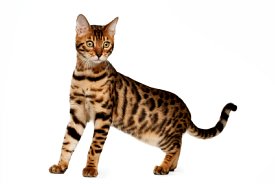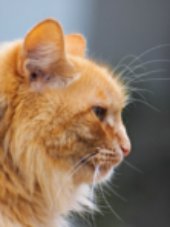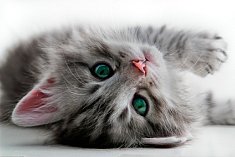|
Cat Anatomy: Interesting Facts About Your Cat's Body

Understanding cat anatomy will help you better understand your feline friend and reveal what most cat owners already know, cats are very unique creatures. We will be discussing your cat's eyes, noses, ears, senses, bodies and digestive systems. It is your cat’s complex anatomy that has allowed their species to thrive for thousands of years.
Cat Senses: Taste, Touch, Smell, Sight, Hearing
The senses of cats which included their; taste, touch, smell, sight and hearing, are extremely sensitive, allows them to be very aware of their environment and each sense plays a different but important role in cat anatomy.
Sense of Taste
Your cat's tongue consists of papillae, which coats the tongue and allows your cat to effectively groom themselves. Their tongues are full of tastebuds, especially at the back of their throat and tip of the tongue. Cats can experience bitter, acidic and salty flavors. Cats do have the taste buds to taste sweet, however these tastebuds are inactive, resulting in a lack of sweet tooth in cats. Before eating you may notice that your cat sniffs their food, It’s because they rely on their sense of smell to tell them whether or not their food is appetizing.
Sense of Touch (Hair and Skin)
The most sensitive places on your cat's anatomy where the nerve cells are concentrated, are their face and front paws. Your cat's hair helps to protect him/ her from their surroundings like insect bites and stings. There are hot and cold receptors all over your cat's skin, which makes them sensitive to both cold and hot weather. Although cat's bodies are very sensitive to their environment, they are extremely tolerant of heat and enjoy a good sun bath. Most cat's enjoy contact, a nice petting session, from their human companion. Remember that although most cat's do enjoy being petted, it needs to be under their terms. Excessive petting could lead to a biting or scratching kitty, your cat will usually exhibit signs that they've had enough petting, to find out those signs read, How To Stop Cat Biting. Cats especially like to be rubbed behind the ears, under the chin and down the base of their tail, and will usually purr to express their enjoyment. Cats shed their hair naturally throughout the year as the weather pattern changes, it is most noticeable in the spring and fall.
Sense of Smell
An important part of your cat's anatomy is their sense of smell. A cat’s sense of smell is approximately fourteen times stronger than humans.They can smell other animals and humans from great distances and use their very sensitive noses as one way of recognizing their human companions. Cats are particular about smells, much like humans and will try to cover up offensive smells, or refuse to use items that has an offensive scent such as a dirty cat litter box. . Cats depend on their noses for a variety of things; to sniff their food, sniff out danger, identify human and furry family members and even to find a mate. Female cats in heat release a sexual pheremone that males can smell from a distances. When your cat rubs his/her body against you, he/she is marking you with his/her scent and also picking up your scent at the same time.
Sense of Sight
In the day time your cat's generally vision is quiet poor and somewhat blurred. Cat’s are master hunters thanks to their keen sense of sight, they can detect even the slightest movements.Your cat’s achilles heal is that they can easily miss something that is right under their nose- literally, cats have a blind spot underneath their chin. Cats eyes have a tapetum lucidum, which is a reflective layer behind the retina that sends light that passes through the retina back into their eyes, this reflective layer improves their ability to see extremely well in dim light, however contrary to popular beliefs they can not see well in complete darkness.
Sense of Hearing
Sense of hearing plays a very important role in cat anatomy. Cats hear better than dogs and can hear many sounds that humans don’t hear. They can hear 100,000 Hz, which is considered in the ultrasonic range. Our cats perk up their ears and run to the door when visitors come way before the visitor rings the doorbell, we call them our personal alarm cats. Humans can only hear in the 20,000 Hz range. Cats can hear sounds at very low and high frequencies. They mainly use their excellent sense of hearing to hunt and find prey.

Cat Anatomy: Eyes, Nose, Ears
Cat Eyes
Iridescent cells located in the back of the eye reflects light, and is also referred to as “eyeshine.” It is what allows cats to see so well at night. They can even see ultraviolet light, which is not visible to the human’s naked eye. Scientists believe that cats are colorblind. Another interesting fact about cat eyes is that cats have a third eyelid, which they have partial vision through. This third eyelid protects their eyes from injury, such as when they are fighting, hunting or navigating through thick vegetation.
Cat Noses
The cat anatomy of the nose is meant to minimize injuries to the area because of its strong design. Cats secrete odors as a means of communication, and they are also very territorial. Their nose allows them to find food and identify territories.
Cat Ears
There are 32 muscles in a cat’s ears, which make them able to have directional hearing. They can face one direction and point the ears in a different direction. Cats can move each ear independently because of the number of muscles. The angle your cat’s ears are in can be a clue to what mood your cat is in. Flatten ears usually mean that your cat is anxious or frighten, when your cat turns their ears back it usually means your cat is annoyed and becoming defensive, completely flattening their ears straight back usually means your cat is preparing for a fight, so they pull back their ears to protect them, straight erect ears usually means a sound has caught your cat's attention and when your cat's ears are erected forward and a little outward it usually means that you have a happy kitty.
Cat Anatomy:Your Cat's Body
Your cat's bones consist of seven lumbar vertebrae, two more than what humans have, and 13 thoracic vertebrae, one more than humans, which allows their spine more flexibility and mobility. Cats do not have an actual collar bone like humans, but free-floating clavicle bones, which enable them to contort their body in order to fit into small openings.
Your cats back legs allow them to jump and fall from high distances without serious injury. Cats walk directly on their toes and place each paw almost exactly where the previous forepaw was in order to travel through rough ground, it also reduces the amount of tracks they leave behind and noise they make. Cats also have retractable claws that aid them in killing their prey.
Cat Digestive Systems
Cat anatomy includes your cat's digestive system and works much like a human’s does. Their mouth, salivary glands, esophagus, small intestine, large intestine, stomach, liver, and pancreas, all work together to process food and absorb the nutrients. Cats utilize their lips, mouth, teeth, tongue and salivary glands to take in food, which then travels down the esophagus. Cats have 30 permanent teeth they use to chew their food: 12 incisors, four canines, 10 premolars and four molars. Their canines are very sharp so they can hold onto and properly tear into their food.From your cat’s esopahagus, the food makes it way to the small intestine, where digestive enzymes break down food. Bile and pancreatic secretions break down proteins and carbohydrates. Cat anatomy includes the liver which creates bile, and the pancreas makes the digestive enzymes. The large intestine is responsible for helping to eliminate the waste products out of your cat’s body.

Cat Anatomy: Your Cat's Whiskers
Cat anatomy also consists of your cat's whiskers, which are also known as orvibrissae or tactile hairs. They are flexible wire-like horizontal strands, which are about three times thicker than their fur. They are rooted deeply in your cat’s face and should never be trimmed or cut off because your cat relies on them to move around. Your cat uses their whiskers to walk around at night and successfully navigate around furniture. Whiskers work like radar and are so sensitive, they can sense the change of the wind current in a room. In addition to using whiskers for navigation, cats also use their whiskers to measure an opening they want to crawl through and also to indicate their mood. Whiskers that are pushed forward and relaxed show that your cat is content or curious. When whiskers are pulled back, it indicates anger or defensiveness.
Similar Topics
Feline Eye Infection: Causes And Effective Treatments - Discussing different types of feline eye infections, causes and treatment options. Feline Skin Problems: Causes And Effective Treatments - Feline skin problems can be both irritating and very uncomfortable for your cat. Read to find out symptoms to be aware of and effective treatment options.
Return From Cat Anatomy To Cat Health Home Page
|
Protect Your Pet Card
In Case Of An Emergency The Protect Your Pet Card Lets Emergency Services Know That You Have Pet/Pets Waiting For You At Home, Making Sure That Your Pets Are Cared For.
Get Your Card Today!
Win A Free $250 Petsmart Gift Card For Your Cat!
Must Be A US Resident
Click Here To Easily Enter For Your Chance To Win.

"There are few things in life more heartwarming than to be welcomed by a cat."






